what are all of the x-intercepts of the continuous function in the table?

Mathematics, 19.09.2019 03:50 rosebebo7615
Answer quick
what are all of the x-intercepts of the continuous function in the table?
a (0, 8)
b (–4, 0)
c (–4, 0), (4, 0)
d (–4, 0), (0, 8), (4, 0)
table
x f(x)
-4 0
-2 2
0 8
2 2
4 0
6 -2

Answers: 1


Other questions on the subject: Mathematics

Mathematics, 21.06.2019 20:00, 12bluestone
Someone answer asap for ! a discount store’s prices are 25% lower than department store prices. the function c(x) = 0.75x can be used to determine the cost c, in dollars, of an item, where x is the department store price, in dollars. if the item has not sold in one month, the discount store takes an additional 20% off the discounted price and an additional $5 off the total purchase. the function d(y) = 0.80y - 5 can be used to find d, the cost, in dollars, of an item that has not been sold for a month, where y is the discount store price, in dollars. create a function d(c(x)) that represents the final price of an item when a costumer buys an item that has been in the discount store for a month. d(c(x)) =
Answers: 1

Mathematics, 21.06.2019 21:40, joeykyle05
Write the contrapositive of the conditional statement. determine whether the contrapositive is true or false. if it is false, find a counterexample. a converse statement is formed by exchanging the hypothesis and conclusion of the conditional. a) a non-converse statement is not formed by exchanging the hypothesis and conclusion of the conditional. true b) a statement not formed by exchanging the hypothesis and conclusion of the conditional is a converse statement. false; an inverse statement is not formed by exchanging the hypothesis and conclusion of the conditional. c) a non-converse statement is formed by exchanging the hypothesis and conclusion of the conditional. false; an inverse statement is formed by negating both the hypothesis and conclusion of the conditional. d) a statement not formed by exchanging the hypothesis and conclusion of the conditional is not a converse statement. true
Answers: 1

Mathematics, 21.06.2019 23:50, lanettejohnson355
What is the slope of the line that passes through the points (–9, 2) and (0, 4)? the slope of the line is
Answers: 2

Mathematics, 22.06.2019 01:00, ashiteru123
Multiply: 2.7 × (–3) × (–1.2). a. –9.72 b. –10.8 c. 10.8 d. 9.72
Answers: 2
You know the right answer?
Answer quick
what are all of the x-intercepts of the continuous function in the table?
what are all of the x-intercepts of the continuous function in the table?
Questions in other subjects:










History, 25.02.2020 17:00




